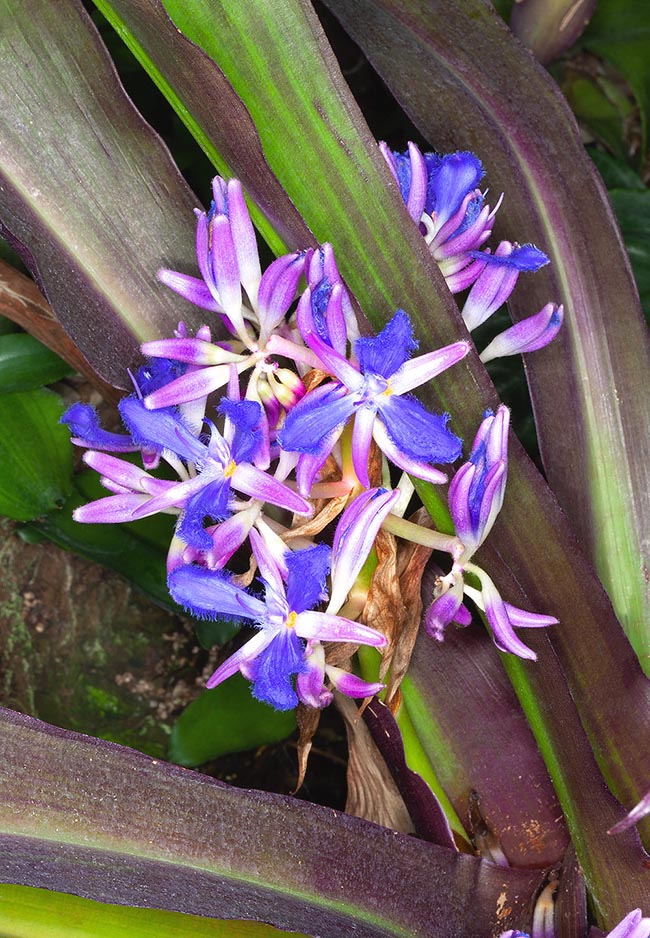Family : Commelinaceae

Text © Pietro Puccio

English translation by Mario Beltramini
The species is native to Colombia, Costa Rica, Ecuador, Nicaragua and Panama where it grows on the trees of the rainforests, from the sea level up to about 300 m of altitude.
The name of the genus, as reported by the author, is the combination of the Greek substantives “κοχλιών” (cochlion) = spiral screw and “στῆμα” (stéma) = stamen; the name of the species is the superlative of the Latin adjective “odoratus, a, um” = odorous, fragrant, with reference to the flowers.
Common names: principe azul, tira (Spanish).
The Cochliostema odoratissimum Lem. (1859) is an acaulescent, evergreen herbaceous species, epiphyte, rarely terrestrial, with a compact rosette of spirally arranged leaves, simple, oblong-lanceolate with attenuated base, acute apex and entire margin, 0,4-1,2 m long and 10-15 cm broad, thick, of green colour more or less suffused of brown red.

The Cochliostema odoratissimum is an acaulescent evergreen herbaceous epiphyte, rarely terrestrial, of Central America. Its big leaves, arranged in a spiral and compact rosette that collects the rainwater with debris nourishing for the plant, remind the strategy of Bromeliaceae. Unusual very fragrant flowers with undoubtful ornamental value © Giuseppe Mazza
In the rosette the overlying foliar bases form a sort of container where gather vegetal debris and water that contribute to the nourishment of the plant.
Ramified axillary inflorescences, 25-50 cm long, with big bracts of pinkish white colour at the base of the ramifications and numerous flowers intensely fragrant, of 4-6 cm of diameter.
Calyx with 3 free oblong sepals with obtuse apex, concave, purplish pink, 1,5-3 cm long and 0,5-1 cm broad.
Corolla with 3 ovate petals, 1,5-3 cm long and 0,5-1 cm broad, of purplish light blue colour and thickly fringed with moniliform hairs, 3 staminoids, of which 2 petaloid of purple colour, linear, fringed, 0,5-1 cm long, and one reduced to a short tuft of yellow hairs, 3 fertile stamens with filaments merged at the base and dilated to form a petaloid hooded column (shaped like a hood), 1,5-2 cm long, with convoluted margins that encloses wholly 3 anthers spirally twisted, one horizontal at the base and two erect parallel, ovoid trilocular ovary, curved style, 1-1,5 cm long, and stigma with three tiny lobes.
The fruits are triparted oblong capsules, about 3 cm long and of 0,5 cm of diameter, containing numerous seeds of brown colour.
It reproduces by seed, placed superficially in draining organic loam maintained humid at the temperature of 26-28 °C.
Species of great ornamental value that displays absolutely unusual characteristics in the family: the arrangement of the leaves that recalls that of the Bromeliaceae, the intense scent emanated by its flowers and the complex structure of the flower.
Cultivable in open air exclusively in the tropical and humid subtropical climate regions, on the trees, as in nature, or on the ground in draining and aerated organic loam maintained constantly humid, but without stagnations, in a particularly luminous position but not in the direct sun.
Elsewhere, it is to be kept in a particularly luminous greenhouse with lowest temperatures not under the 16 °C, high humidity, 70-85 %, and a constant aeration, utilizing pots or baskets with a loam having the above cited characteristics or a compost for epiphyte orchids. Watering are to be done with rainwater, demineralized or by reverse osmosis at ambient temperature and the fertilizations, in spring summer, with a hydrosoluble product balanced with micro-elements very diluted compared to the recommended doses.
Synonyms: Cochliostema odoratum K.Koch (1859); Cochliostema jacobianum K.Koch & Linden (1867); Cochliostema jacobianum var. variegatum Van Geert (1881).
→ To appreciate the biodiversity within the COMMELINACEAE family please click here.
